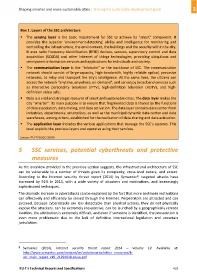Page 443 - Shaping smarter and more sustainable cities - Striving for sustainable development goals
P. 443
Box 1. Layers of the SSC architecture
The sensing layer is the basic requirement for SSC to achieve its "smart" component. It
provides the superior 'environment‐detecting' ability and intelligence for monitoring and
controlling the infrastructure, the environment, the buildings and the security within the city.
It uses radio frequency identification (RFID) devices, sensors, supervisory control and data
acquisition (SCADA) and other Internet of things technologies, providing ubiquitous and
omnipotent information services and applications for individuals and society.
The communication layer is the “infobahn” or the backbone of SSC. The communication
network should consist of large‐capacity, high‐bandwidth, highly reliable optical, pervasive
networks, to relay and transport the city's intelligence. At the same time, the citizens can
access the network "anytime, anywhere, on‐demand", and can enjoy broadband services such
as interactive personality television (IPTV), high‐definition television (HDTV), and high‐
definition video calls.
Data is a vital and strategic resource of smart and sustainable cities. The data layer makes the
city "smarter": its main purpose is to ensure that fragmented data is shared by the functions
of data association, data mining, and data activation. The data layer contains data center from
industries, departments, enterprises, as well as the municipal dynamic data center and data
warehouse, among others, established for the realization of data sharing and data activation.
The application layer includes the various applications that manage the SSC's systems. This
level exploits the previous layers and operates using their services.
Source: ITU‐T FG‐SSC (2014)
5 SSC services, potential cyberthreats and protective
measures
As the overview provided in the previous section suggests, the infrastructural architecture of SSC
can be vulnerable to a number of threats given its complexity, cross‐level nature, and extent.
According to the Internet security threat report (2014) by Symantec , targeted attacks have
8
increased by 91% in 2013, with a wide variety of attackers and motivations, and increasingly
sophisticated techniques.
The dramatic increase in cyberattacks can be explained by the fact that more and more motivations
can effectively and efficiently be served through the Internet. Perpetrators are attracted and can
succeed, because cyberattacks are less detectable than physical actions, they do not physically
expose the attackers, can be extremely inexpensive, can be launched by a geographically remote
location, the attribution is extremely difficult, and even if someone is identified, the prosecution is
even more problematic due to the lack of definitive international legislation and uncertain
jurisdiction.
8 Symantec (2014), Internet security threat report 2014 – Volume 19. Available at:
http://www.symantec.com/content/en/us/enterprise/other_resources/b‐
istr_main_report_v19_21291018.en‐us.pdf
ITU‐T's Technical Reports and Specifications 433

